|
MOUND
72
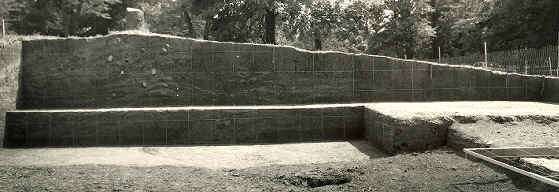
CLICK ON PICTURE FOR LARGE IMAGE
EXCAVATION
IN PROGRESS OF MOUND 72 SHOWING PROFILE AND GRID LINES
PICTURE
CREDIT JIM ANDERSON
The excavation of mound 72 began in 1967 and continued for five digging
seasons through 1971. Mound 72 was excavated as a direct result of a
project called the Cahokia Mapping Project by the University of Wisconsin-Milwaukee
to classify and map the various mounds at Cahokia. It was determined that
Mound 72 held an important position by its orientation and alignment with
various other mounds.
Mound 72 is a ridge-top mound and one characteristic of these
types of mounds at Cahokia is that 5 out of the 8 known examples are
located at the outer most limits of the mound area. Many of the mounds at
Cahokia seem to have been constructed at locations along certain alignment
points within the mound system. It was thought that an important alignment
was convergent at a point on the southeastern portion of this mound and it
was here that excavation began. It was theorized that mound 72 might
be a "marker mound" that contained the location of a
marker post. A large post pit was found which at one time contained a
large pole three feet in diameter. The base of the pole was placed
approximately eight feet into the ground and surrounded by small cedar
logs to form a crib for extra support. This cribbing was found still in
place but the main pole had been removed. A carbon date of the cedar logs
indicate a date of 1000 A.D.

CLICK ON PICTURE FOR LARGE IMAGE
MOUND
72 EXCAVATION SHOWING THE PROFILE OF TWO PRIMARY MOUNDS
PICTURE
CREDIT JIM ANDERSON
Mound 72 was a complicated multiple mound "system".
It was not a single mound that was constructed in a few days. It was built
in several stages with at least three primary mounds over a period of
several years. Primary mound 1 was built over the first large post pit
discovered in the excavation and contained a burial of an important
individual who was laid out on a bed of shell beads in the shape of a
bird. Several other burials that seem to be offerings along with grave
goods were also found in the first primary mound. Primary mound 2 was
built over another large post pit along with another important individual
who was also buried with several grave goods and burials. Several later
modifications was also done to one of these mounds. Primary mound 3 was
constructed between the first two mounds and was built over a large burial
pit containing over 53 young women ages 15 to 30 and four males with heads
and hands removed. Finally the last stage of mound construction covered
all three initial primary mounds with one large ridge-top mound. The orientation
of the ridge is along the solstice angle.
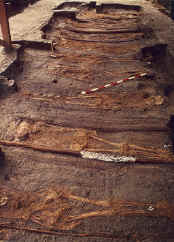
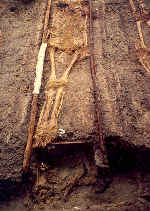 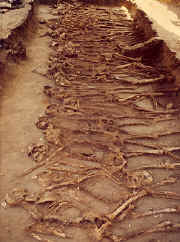
CLICK ON LEFT PICTURE FOR LARGE IMAGE
SACRIFICIAL BURIALS
PICTURE CREDIT JIM
ANDERSON
The two rows of burials in these pictures, one laid on top of the other, were placed along
the southwest margins before the final construction of mound 72. The upper
row (feature 229) in the picture to the left are known as the "litter
burials". Several of these burials were tightly bound and all are lying on
cedar litters. A sample for radio carbon dating was taken were the
aluminum foil is covering the wooden pole. The wood dates to approximately
1000 A.D.
272 burials were
discovered in mound 72. These burials were located within twenty five
different features and interred over a period of several years as the
mound structure continued to expand. Most of the burials were sacrificial
offerings and placed there as either extended or bundle burials. High status burials
in mound 72 would include two burials known as the "beaded
burials". They are located under primary mound 1 in feature 101 where
one individual was buried under a layer of over 20,000 beads and one
individual on top of the beads. These beads were laid out in a design of a
bird similar to other Mississippian art work. The combination of both
human and bird can be seen in the birdman tablet (click
here to view 2 birdman tablets)
from Cahokia.
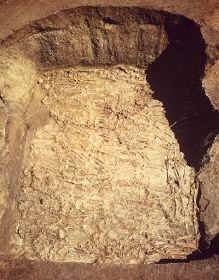
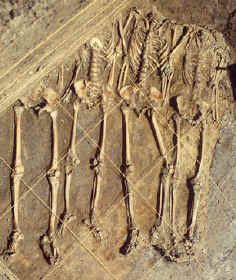
SACRIFICIAL BURIALS
PICTURE
CREDIT JIM ANDERSON
These two burial features were located in primary mound 3. The picture at
left shows the "female burial pit" where 53 individuals were
found. Their estimated ages are between 15 to 30 years of age. The four
male burials in the picture to the right were missing their heads and hands.
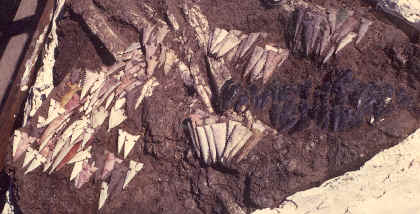
CLICK ON PICTURE
FOR A VERY VERY LARGE IMAGE
PROJECTILE POINT CACHE #1550
OWNED BY
THE PEOPLE OF ILLINOIS----PICTURE CREDIT JIM ANDERSON
This picture
shows one of two caches of stone arrow points recovered from primary mound
1. These points were hafted on arrows when they were placed with a burial
in feature 102. The points in this cache have both stylized versions of
Cahokia points and Caddoan points from Arkansas, Oklahoma and Texas. Plus
some "classic" Cahokia point types.
CLICK
HERE FOR AVAILABLE MOUND 72 POINT CASTS
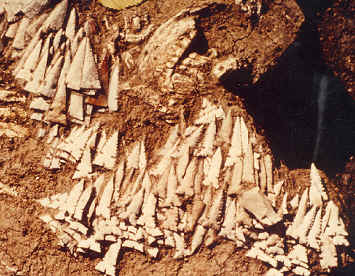
CLICK ON PICTURE
FOR VERY LARGE IMAGE
PROJECTILE POINT CACHE #1551
OWNED BY THE PEOPLE
OF ILLINOIS, PICTURE
CREDIT JIM ANDERSON
This picture shows another projectile point cache that was found in
primary mound 1 with a burial in feature 102. There were 413 points in
this group. They were also originally hafted on arrows when placed in the
mound. Of the three caches this one contained the most artistic group of
points. They are stylized versions of both Cahokia and points that have
been found at Spiro Mounds in Oklahoma. Most of these points are made of
white Burlington chert that may have come from either Illinois or
Missouri.
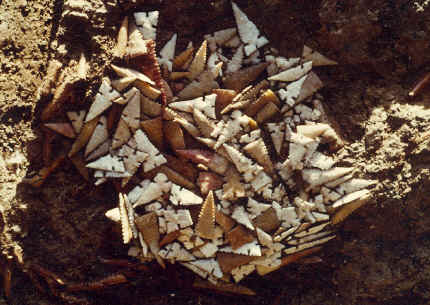
CLICK
ON PICTURE FOR VERY LARGE IMAGE
PROJECTILE POINT CACHE #1970
OWNED BY
THE PEOPLE OF ILLINOIS, PICTURE
CREDIT JIM ANDERSON
This is the third cache of stone projectile points. It was found in
primary mound 2 in the northwest section of mound 72. A few antler harpoon
points can also be seen scattered around the edges of the cache. This
cache was not hafted on arrows like the other two and was probably laid in
the mound inside some type of organic container that did not survive.
There were 451 points found in this cache.
CLICK
HERE FOR AVAILABLE MOUND 72 POINT CASTS
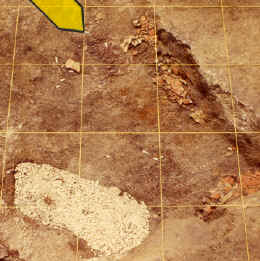 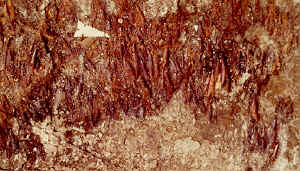
CLICK
ON PICTURE FOR LARGE IMAGES
CACHE
OF BARBED ANTLER PROJECTILE POINTS
OWNED BY
THE PEOPLE OF ILLINOIS---PICTURE
CREDIT JIM ANDERSON
These two pictures illustrate the location of one of the largest caches of
antler arrow points ever found. The yellow arrow points to the location of
the cache. The several hundred antler points in this cache appear to have
all been hafted onto arrows at the time they were placed in the mound. The points are located near some
broken seed jars in feature 236 in primary mound 2. Antler points may have
been a common point type used by Mississippian people. They have been
found on other Mississippian sites in the southeast. Three barbed antler
projectile points were found many years ago by Ed Rouch who at one time
owned and farmed some of the land now incorporated into the Cahokia Mounds
State Historic Site. One complete example has very fine engraved
concentric circles around the tip of the point. This engraving was not
noticed until a picture was taken of it.
Click
here to see a close-up of the engraving.

BARBED ANTLER ARROW POINT
CAHOKIA MOUNDS
SITE
PRIVATE
COLLECTION----PICTURE CREDIT PETE BOSTROM
This antler point was found many years ago by Ed Rouch on the Cahokia
Mounds site. Notice the engraving on the tip of the point.
|














